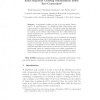Free Online Productivity Tools
i2Speak
i2Symbol
i2OCR
iTex2Img
iWeb2Print
iWeb2Shot
i2Type
iPdf2Split
iPdf2Merge
i2Bopomofo
i2Arabic
i2Style
i2Image
i2PDF
iLatex2Rtf
Sci2ools
WEA
2010
Springer
2010
Springer
Exact Bipartite Crossing Minimization under Tree Constraints
A tanglegram consists of a pair of (not necessarily binary) trees T1, T2 with leaf sets L1, L2. Additional edges, called tangles, may connect nodes in L1 with those in L2. The task is to draw the tanglegram with a minimum number of tangle edge crossings while making sure that no crossing occurs between edges within each tree. This problem has relevant applications in computational biology, e.g., for the comparison of phylogenetic trees. In this work, we show that the problem can be formulated as a quadratic linear ordering problem (QLO) with additional side constraints. In [2] it was shown that, appropriately reformulated, the QLO polytope is a face of some cut polytope. It turns out that the additional side constraints arising in our application do not destroy this property. Therefore, any polyhedral approach to max-cut can be used in our context. We present experimental results for drawing random and realistic tanglegrams on binary and on general trees. Using both linear and semide�...
| Added | 18 May 2010 |
| Updated | 18 May 2010 |
| Type | Conference |
| Year | 2010 |
| Where | WEA |
| Authors | Frank Baumann, Christoph Buchheim, Frauke Liers |
Comments (0)

